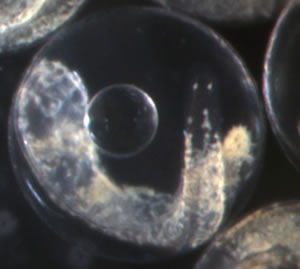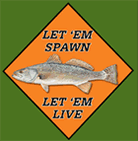Spawning and Production of Spotted Seatrout
Spotted seatrout are dependent on the shallow estuarine flats typical of coastal South Carolina and they are particularly vulnerable to catastrophic winter kills that can occur when water temperatures decrease before fish can move to deeper, warmer waters. Because these winter kills can result in drastic declines in seatrout abundance, SCDNR is developing a stock enhancement research program designed to answer questions about spotted seatrout ecology and supplement the population as needed. As spotted seatrout production has never occurred in South Carolina, we are developing protocols for broodstock management, spawning, and pond production from the ground up.

To date, approximately 120 adult spotted seatrout have been captured and held in captivity at the Marine Resources Research Institute (MRRI) in Charleston, SC. Each fish was weighed, measured, and PIT tagged and a fin clip was taken for genetic evaluation. Spotted seatrout broodstock were separated into multiple groups of approximately 20 fish per tank, with a relatively even ratio of males and females. Each tank represents a genetic “family,” meaning the offspring of that family can be genetically identified back to the tank in which they were spawned. Preliminary analyses show some genetic differences between seatrout in different estuaries along the coast. As a result, broodstock collected from the Charleston Harbor system will only be used to produce fingerlings for stocking in the Charleston Harbor system. Spotted seatrout, like many fish species, use water temperature and day length as cues to begin spawning in the wild. Therefore, each tank was placed on a conditioning cycle, designed to reflect the temperature and daylight schedules the fish would experience in the wild.
Unlike our experiences with red drum, we have had limited success so far with volitional or voluntary spawning. As a result, standard hormone induction methods have been applied to trigger spotted seatrout to spawn, and temperatures have been managed to keep them in spawning condition. In year one (2011), spotted seatrout broodstock from two families spawned a total of 31 times from May to November, producing approximately 14.5 million eggs. In our second year (2012), we have seen a sharp increase in the number of spawns and egg production. From May 2012 to the present, spotted seatrout from 4 different families spawned 64 times, producing 55.7 million eggs. We have also seen an increase in the number of viable eggs (live, fertilized, fig. 1) from 42% in 2011 to 78% in 2012. We have estimated that there are 2,000 eggs per milliliter of water in a series of subsamples counted under a microscope. Understanding the relationship between number of eggs and volume allows us to increase hatch rates by putting the correct number of eggs in hatching cones and this means more larvae to stock into ponds.

These larvae are then transported to the Waddell Mariculture Center in Bluffton, SC for stocking into 0.6 acre and 1.2 acre saltwater ponds. Prior to stocking, each pond is filled with seawater and fertilized to initiate a phytoplankton (algae) bloom that in turn results in an increase of the tiny crustacean-like animals that will feed the seatrout larvae in their first few weeks of life. After the first week, supplemental feedings of brine shrimp followed by commercial fish pellets are added to each pond. Ponds were stocked with between 150,000 and 800,000 larvae, in an attempt to determine the appropriate stocking numbers necessary to maximize production of robust, healthy fish. During the grow-out phase, each pond is sampled weekly using a net dragged just under the surface of the water. When the fish in a pond reach approximately 1-2 inches, the pond is ready to be harvested. The water is drained completely and fish are corralled into a concrete catch basin that sits below the surface of the pond. From there, they are netted into water filled buckets (fig. 2), weighed, and placed in an oxygenated fish hauling trailer for transportation to their release location. Several subsamples of fish per given amount of weight are counted and these results are used to determine the total number of fish harvested from a pond.
While much of year one (2011) was spent trying to initiate spawns from newly captured broodstock, we did have some success producing fingerlings in saltwater ponds. A total of nine ponds were stocked and a total of 319,283 seatrout fingerlings were harvested. In year two, 14 more ponds were stocked and a total of 381,594 seatrout were harvested. Some of the fish harvested in both years were used in studies involving handling mortality, cannibalism, and tolerance to cold temperatures. Additionally, three genetic families of fish harvested in 2012 have been stocked in locations within the Wando River, Charleston Harbor, and the Ashley River.

Through two years of experimentation, we have begun to refine our husbandry techniques to maximize production of healthy fish that have the best chance of survival. Spotted seatrout are extremely cannibalistic and we have found that when left in a pond for too long, the larger fish will prey heavily on their brothers and sisters until there are only a few hundred very large fish left. On the other hand, harvesting a pond too early will result in a large number of fish, but they may be too small and weak to survive the handling process. Additional factors, such as water temperature and the amount of natural prey availability may also have large impacts on the process, resulting in wide variation in harvest numbers. However, preliminary data suggests that harvesting a pond between days 25-35 will maximize our production of fish in the 1-2 inch range that are large enough to survive handling (fig. 3). Finding the balance between harvest numbers and fish size is an essential step in developing a stock enhancement program and maximizing the efficiency of state funds. In the future, we will work to further refine production techniques in order to produce robust uniformly-sized spotted seatrout for a wide variety of stock enhancement experiments.



